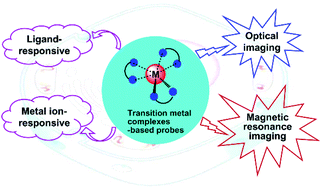Bioimaging agents based on redox-active transition metal complexes
Abstract
Detecting the fluctuation and distribution of various bioactive species in biological systems is of great importance in determining diseases at their early stages. Metal complex-based probes have attracted considerable attention in bioimaging applications owing to their unique advantages, such as high luminescence, good photostability, large Stokes shifts, low toxicity, and good biocompatibility. In this review, we summarized the development of redox-active transition metal complex-based probes in recent five years with the metal ions of iron, manganese, and copper, which play essential roles in life and can avoid the introduction of exogenous metals into biological systems. The designing principles that afford these complexes with optical or magnetic resonance (MR) imaging properties are elucidated. The applications of the complexes for bioimaging applications of different bioactive species are demonstrated. The current challenges and potential future directions of these probes for applications in biological systems are also discussed.

- This article is part of the themed collection: 2022 Chemical Science Perspective & Review Collection


 Please wait while we load your content...
Please wait while we load your content...